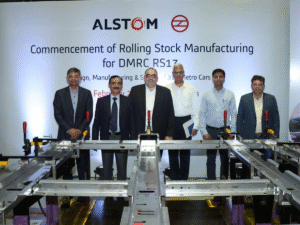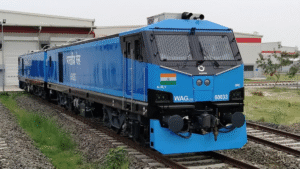Rail Analysis: “Innovation and sustainability go hand in hand in modern mobility.” How does Alstom incorporate these values into its operations and solutions in India?
Shri Puneet: At Alstom, innovation and sustainability are two pillars that go hand in hand. We are committed to supporting both the Indian and global markets in their transition toward greener railways. Our aim aligns with Indian Railway’s goals of becoming a green railway by 2030 and achieving net-zero emissions by 2070. Beyond manufacturing trains, Alstom brings the latest technologies, such as ETCS Level 3, deployed for the first time in the world in India by Alstom.
 Strengthening India’s Urban Mobility: Alstom Commences Rolling Stock Manufacturing for DMRC’s RS17 Project
Strengthening India’s Urban Mobility: Alstom Commences Rolling Stock Manufacturing for DMRC’s RS17 Project
These technologies help eliminate human errors and create more efficient, safe, and reliable mobility solutions for the future. This system enables advanced communication and automatic train operations. We are also developing train-to-train communication systems and driverless train operations.
At Alstom, innovation and sustainability are two pillars that go hand in hand. We are committed to supporting both the Indian and global markets in their transition toward greener railways. Our aim aligns with Indian Railways’ goals of becoming a green railway by 2030 and achieving net-zero emissions by 2070.
Rail Analysis: In 2025, Alstom began implementation of its CBTC signaling system across Bengaluru Metro Phase 2. How will this project reshape urban mobility in the city, and what technological advantages does the CBTC solution bring to passengers and operators alike?
Shri Puneet: CBTC, or Communication-Based Train Control, is a vital innovation in modern urban transport. Alstom has deployed this system extensively in India, with significant work in Bangalore Metro. In Phase 1, we implemented about 78 kilometres of signalling, which is already operational and revenue-generating. This remains the only system in full operation in the city as of now. In Phase 2, covering approximately 80 kilometres, we are introducing driverless train operations. This not only improves punctuality and optimises energy use but also provides automated real-time information to commuters.
 Precision Beneath the City: Advancing Tunnel Infrastructure for Urban Metro Networks
Precision Beneath the City: Advancing Tunnel Infrastructure for Urban Metro Networks
Importantly, this line will connect the airport to the city centre, significantly reducing traffic congestion in Bangalore – a city notorious for it. Our solution, based on the advanced Urbalis platform, is also being implemented in other parts of India and globally.
In Phase 2, covering approximately 80 kilometres, we are introducing driverless train operations. This not only improves punctuality and optimises energy use but also provides automated real-time information to commuters—greatly enhancing the passenger experience.
Rail Analysis: In what ways do you see Alstom potentially contributing to the expansion and technological advancement of the Kavach project in India?
Shri. Puneet: Kavach is a crucial safety initiative by Indian Railways, and Alstom is deeply involved in supporting its development and deployment.
 Powering Freight Movement: Next-Gen WAG12B Electric Locomotive on Track
Powering Freight Movement: Next-Gen WAG12B Electric Locomotive on Track
We collaborate with various railway entities like NCRTC to implement advanced solutions that enhance safety and operational efficiency. For example, we have implemented one of the most advanced signaling systems in the world, ETCS Level-2 – in partnership with NCRTC – enabling Namo Bharat trains to run at operational speeds up to 160 kmph, safely and efficiently. Our focus remains on offering cost – effective, high – performance, and future-ready systems to support the government’s vision for safe, modern rail infrastructure.
Rail Analysis: Can you share any examples of how Alstom is leveraging digital technologies to improve rail systems in India?
Shri Puneet: Alstom’s signalling systems are fortified with comprehensive cybersecurity measures. Every solution, whether for metro or mainline, includes secure Linux-based telecom systems, making them resilient to cyber threats. We are also pioneering digital technologies like AI and IoT for predictive maintenance and driverless operations. In Delhi, our driverless system is operational, and we are expanding to Mumbai, Bangalore, and other cities. AI-based data analytics help us predict and address maintenance issues proactively, enhancing system uptime and passenger safety. This complete digital ecosystem is part of our broader commitment to smart, secure, and efficient urban mobility.
Also, Alstom has recently launched its largest digital experience centre for the development of next generation signalling solutions in India. This innovation hub supports signalling technology R&D and project deployment at varied levels, for more than 120 projects in India and worldwide.
Rail Analysis: With the rise of smart cities, how do you see Alstom’s solutions integrating with India’s urban transportation networks in the coming years?
Shri Puneet: A smart city cannot exist without smart mobility. At Alstom, we address this through three core areas: digital mobility solutions, smart modernisation, and sustainable technologies. We offer multimodal platforms that help manage passenger flow and incidents in real-time.
A smart city cannot exist without smart mobility. At Alstom, we address this through digital mobility solutions, smart modernisation, and sustainable technologies. From eco-driving aids to predictive maintenance tools and last-mile connectivity, we focus on creating inclusive, efficient, and sustainable urban environments.
Our advanced signalling systems boost safety and efficiency. We also implement smart energy-saving technologies, like eco-driving aids for operators, which reduce energy use and improve operational performance.
 Urban Mobility in Motion: Modern Metro Train at Elevated Station Platform
Urban Mobility in Motion: Modern Metro Train at Elevated Station Platform
Our predictive maintenance tools extend system life and reduce costs. Finally, through CSR, we support last-mile connectivity, such as our LEAP auto project in Bangalore, which connects residential areas with metro stations. This holistic approach supports the vision of inclusive, efficient, and sustainable urban environments.
Rail Analysis: How does Alstom view the future of the Indian metro and urban transport market with over 30 upcoming metro, Metrolite, and Metro Neo projects?
Shri Puneet: The metro landscape in India is rapidly evolving. Initially focused on Tier-1 cities, the expansion is now reaching Tier-2 cities like Bhopal, Indore, Surat, Patna, and Bhubaneswar.
Authorities in these cities are looking for efficient yet cost-effective solutions. Alstom actively engages in discussions on standardising features and technologies across projects to enable faster deployment and simplified maintenance.
This approach is being welcomed by the ministry and project owners, making it easier to manage growth at scale. We believe India is entering a phase of significant transformation, and standardized, scalable, and sustainable solutions will be key to its urban mobility success.
Images Credit: Alstom India
This Interview is a part of our latest Magazine: Subscribe to our Magazine Today!
![]() Timely insights, straight to your WhatsApp—stay updated with ease!
Timely insights, straight to your WhatsApp—stay updated with ease!
![]() Stay connected to the rail industry—timely news, straight to Telegram!
Stay connected to the rail industry—timely news, straight to Telegram!


